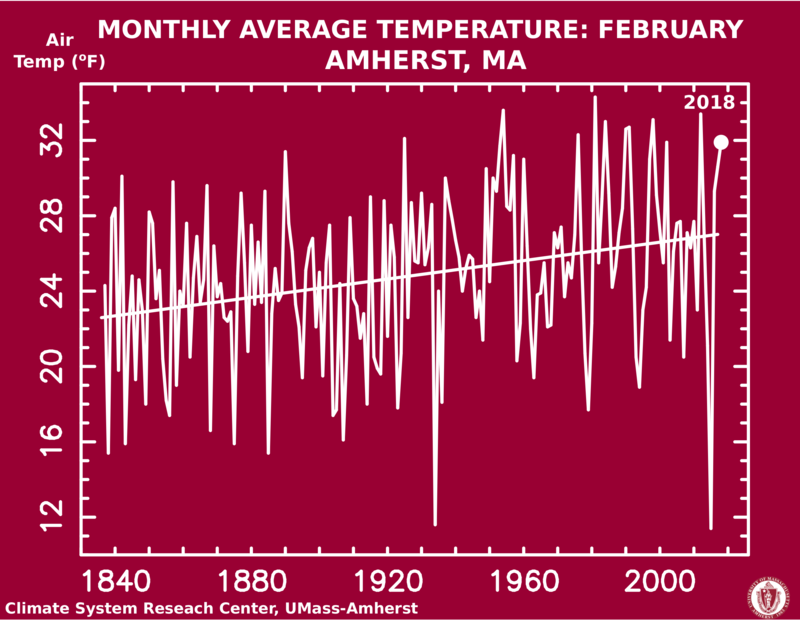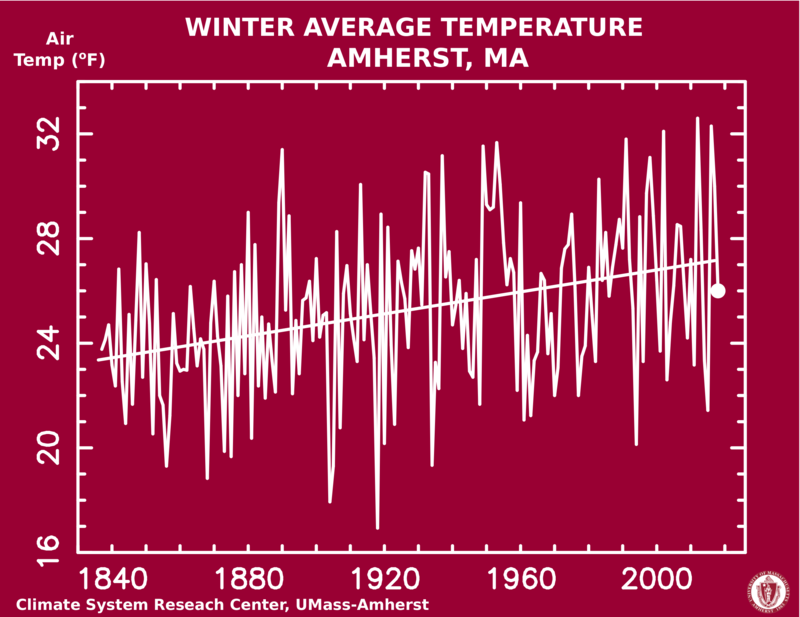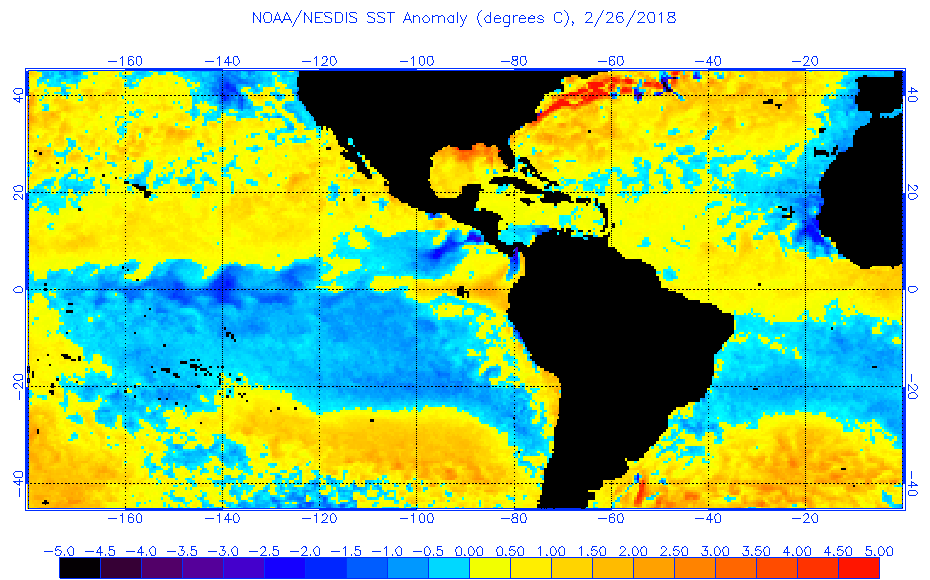Has this winter seemed unseasonably warm to you? Or what about that shocking cold a couple months ago? It turns out that with one of the warmest Februarys on record and a record-breaking two-week cold snap around New Year’s, the winter itself averaged out to be … well … average.
We still have a few weeks to go before the official first day of spring, but meteorological winter — which scientists define as the months of December, January, and February — is behind us.
Michael Rawlins, a University of Massachusetts Associate Professor of Geosciences and an investigator for the Northeast Climate Science Center, said over the past 125 years of collected data, this winter’s temperature average in Amherst came out to 63rd highest — exactly in the middle.
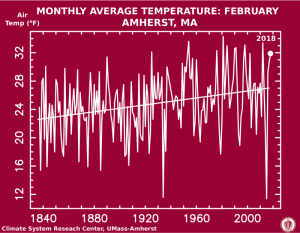
A graph of February temperatures. Since 1836, this February was one of the hottest recorded. Image courtesy Michael Rawlins.
But according to a warming trend line, which shows that winters have warmed in Amherst by 4.4 degrees Fahrenheit since 1836, this winter was actually colder than average for what can be expected for Amherst, despite a February that tied for the 10th hottest recorded.
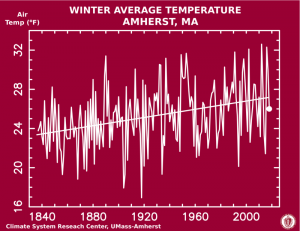
This graph shows average temperature for all winters. This past one was average, but below the trend line. Image courtesy Michael Rawlins
“The February average temperature in Amherst was 31.9 Fahrenheit, which is interesting,” Rawlins said. “If it was two-tenths of a degree warmer, 32.1 degrees, the average February temperature would have been above freezing.”
Warmer winters, with periodic blasts of cold, may be what the region can typically come to expect during wintertime, according to various climate research.
Generally, temperatures are warming, and in the Northeast they are warming faster than anywhere else in the country except Alaska, according to a research paper published through the Northeast Climate Science Center last year.
In addition to that trend, the jet stream — a powerful band of wind encircling the Arctic — has weakened, which allows more frequent blasts of frigid air to escape from the Arctic region, and was the likely cause of the two-week cold snap around New Year’s. That same weakening has also allowed warm air to penetrate to Greenland and the North Pole, explaining some of the above-freezing temperatures experienced there recently.
Still, overall things will get warmer, Rawlins said. He looks at the ratio of how many record warm days there are compared with record cold days.
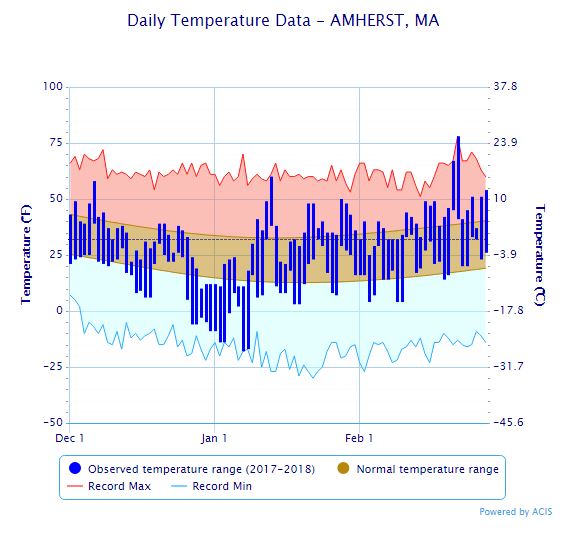
A graph of observed high and low temperatures for Amherst overlaid with record high and low temperatures for that location. Source: NOAA
“Under a stable climate, there would be an equal number of record warm and record cold days on average,” he said. “In recent years we’re seeing ratios of 2-to-1 to 3-to-1. Climate models project that by the end of the century, the ratio of record highs to record lows could reach as high as 50-to-1.”
That’s 50 times more record-breaking warm days than record-breaking cold days each year.
In 2017, the ratio was 2.7 to 1, according to Rawlins.
So far 2018 actually has more record-breaking lows. This past winter held three record-breaking lows (-14 on January 3, -18 on January 7, and -17 on January 8) and two record-breaking highs (67 on February 21 and a summery 78 on February 22).
Richard Palmer, university director of the Northeast Climate Science Center, said climate models show higher variability in weather as the climate warms.
“Not only might we see these changes in unusually warm winter days but some of the longer-term impacts we anticipate are changes in the hydrological cycle, when it snows and when it rains,” he said.
Palmer, who is also a civil and environmental engineering professor, said engineering and biological systems will take time to become accustomed to new anomalous events, including the recent drought and rainier winters.
In that environment, climate science is also facing attacks from the government. President Donald Trump issued a budget request for the number of Climate Science Centers, of which the Northeast Center is one, to drop from eight to three.
Palmer said he was hopeful that Congress, and in particular Senator Lisa Murkowski of Alaska, who serves as head of the budget committee for the Department of the Interior, would continue to be supportive of continuing to fund all the Climate Science Centers.
Murkowski represents the state that scientists are finding has seen the greatest effect of climate change so far.
Dave Eisenstadter can be reached at deisen@valleyadvocate.com.

